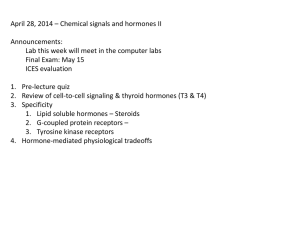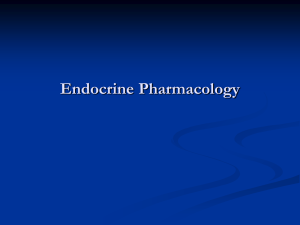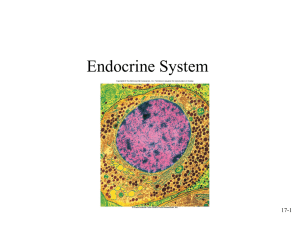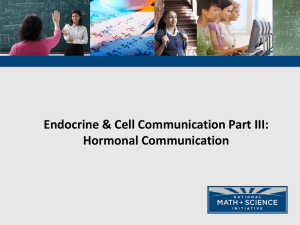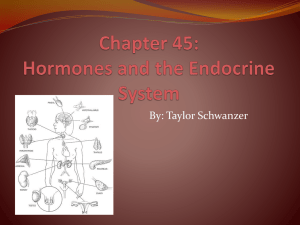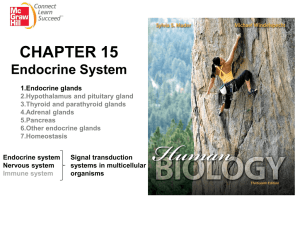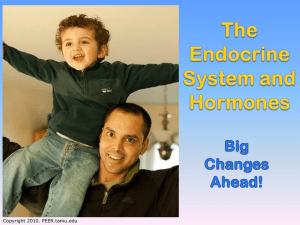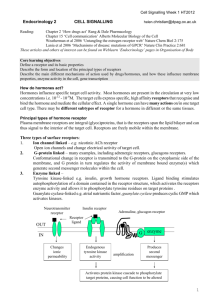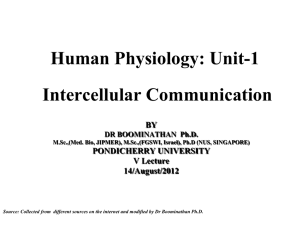Chapter 17
advertisement
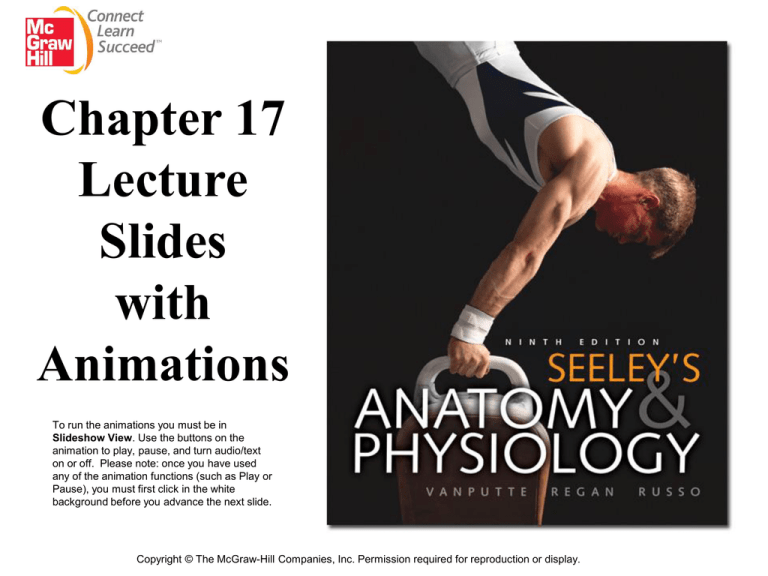
Title Chapter 17 Lecture Slides with Animations To run the animations you must be in Slideshow View. Use the buttons on the animation to play, pause, and turn audio/text on or off. Please note: once you have used any of the animation functions (such as Play or Pause), you must first click in the white background before you advance the next slide. Copyright © The McGraw-Hill Companies, Inc. Permission required for reproduction or display. Chapter 17 Functional Organization of the Endocrine System 17-2 17.1 Principles of Chemical Communication • Classes of Chemical Messengers – Autocrine chemical messengers: released by cells and have a local effect on same cell type from which chemical signals released; e.g., prostaglandin – Paracrine chemical messengers: released by cells and affect other cell types locally without being transported in blood; e.g., somatostatin – Neurotransmitter: produced by neurons and secreted into extracellular spaces by presynaptic nerve terminals; travels short distances; influences postsynaptic cells; e.g., acetylcholine. – Endocrine chemical messengers: type of intercellular signal. Produced by cells of endocrine glands, enter circulatory system, and affect distant cells; e.g., estrogen 17-3 17-4 Characteristics of the Endocrine System • Glands that secrete chemical messengers (hormones) into circulatory system • Hormone characteristics – – – – Produced in small quantities Secreted into intercellular space Transported some distance in circulatory system Acts on target tissues elsewhere in body • Regulate activities of body structures • Ligands: more general term for chemical signals 17-5 Comparison of Nervous and Endocrine Systems • Similarities 1. Both systems associated with the brain • Hypothalamus • Epithalamus 2. May use same chemical messenger as neurotransmitter and hormone. • Epinephrine 3. Two systems are cooperative • Nervous system secretes neuroendocrine peptides, or neurohormones, into circulatory system • Some parts of endocrine system innervated directly by nervous system 17-6 • Comparison of Nervous and Endocrine Systems Differences 1. Mode of transport – Axon – Blood 2. Speed of response – Nervous – instant/milliseconds – Endocrine – delayed/seconds 3. Duration of response – Nervous – milliseconds/seconds – Endocrine – minutes/days – Amplitude vs. frequency 17-7 Please note that due to differing operating systems, some animations will not appear until the presentation is viewed in Presentation Mode (Slide Show view). You may see blank slides in the “Normal” or “Slide Sorter” views. All animations will appear after viewing in Presentation Mode and playing each animation. Most animations will require the latest version of the Flash Player, which is available at http://get.adobe.com/flashplayer. 17-8 17.2 Hormones • General Characteristics of Hormones 1. Stability • Half-life: The length of time it takes for half a dose of substance to be eliminated from circulatory system – – Long half-life: regulate activities that remain at a constant rate through time. Usually lipid soluble and travel in plasma attached to proteins Short half-life: water-soluble hormones as proteins, epinephrine, norepinephrine. Have a rapid onset and short duration 2. Communication • Interaction with target cell 3. Distribution • • Hormones dissolve in blood plasma and are transported in unbound or are reversibly bound to plasma proteins. Hormones are distributed quickly because they circulate in the blood. 17-9 Protein Bound Transport 17-10 17-11 17-12 Patterns of Hormone Secretion • Chronic hormone regulation. Maintenance of relatively constant concentration of hormone. Thyroid hormone. • Acute hormone regulation. Epinephrine in response to stress. • Episodic (Cyclic) hormone regulation. Female reproductive hormones. 17-13 17.3 Control of Hormone Secretion • • Most hormones controlled by negative feedback systems Most hormones are not secreted at constant rate, but their secretion is regulated by three different methods 1. The action of a substance other than a hormone on an endocrine gland. 2. Neural control of endocrine gland. 3. Control of secretory activity of one endocrine gland by hormone or neurohormone secreted by another endocrine gland 17-14 Control by Humoral Stimuli 17-15 Control by Neural Stimuli 17-16 Control by Hormonal Stimuli 17-17 Negative Feedback 17-18 Positive Feedback 17-19 17.4 Hormone Receptors and Mechanisms of Action 17-20 Target Tissue Specificity and Response • Portion of molecule where hormone binds is called binding site. • If the molecule is a receptor (like in a cell membrane) the binding site is called a receptor site • hormone/receptor site is specific; e.g., epinephrine cannot bind to the receptor site for insulin. • The purpose of binding to target tissue is to elicit a response by the target cell. 17-21 Decrease in Receptor Number • Normally, receptor molecules are degraded and replaced on a regular basis. • Down-regulation – Rate at which receptors are synthesized decreases in some cells after the cells are exposed to a hormone. – Combination of hormones and receptors can increase the rate at which receptor molecules are degraded. This combined form is taken into the cell by phagocytosis and then broken down. 17-22 Increase in Receptor Number • Up-Regulation – Some stimulus causes increase in synthesis of receptors for a hormone, thus increases sensitivity to that hormone – For example, FSH stimulation of the ovary causes an increase of LH receptors. Ovarian cells are now more sensitive to LH, even if the concentration of LH does not change. This causes ovulation. 17-23 Classes of Receptors • Lipid-soluble hormones bind to nuclear receptors • Hormones – Lipid soluble and relatively small molecules; pass through the plasma membrane – React either with enzymes in the cytoplasm or with DNA to cause transcription and translation – Thyroid hormones, testosterone, estrogen, progesterone, aldosterone, and cortisol 17-24 Classes of Receptors • Water-soluble hormones bind to membrane-bound receptors: integral proteins with receptor site at extracellular surface. Interact with hormones that cannot pass through the plasma membrane. • Hormones – Water-soluble or largemolecular-weight hormones. Attachment of hormone causes intracellular reaction. – Large proteins, glycoproteins, polypeptides; smaller molecules like epinephrine and norepinephrine 17-25 17-26 Action of Nuclear Receptors • Proteins in cytoplasm or nucleus • Hormones bind with intracellular receptor and receptor-hormone complex activate certain genes, causes transcription of mRNA and translation. These proteins (enzymes) produce the response of the target cell to the hormone • Latent period of several hours because time is required to produce mRNA and protein • Processes limited by breakdown of receptorhormone complex • Estrogen and testosterone produce different proteins in cells that cause the differing secondary sexual characteristics of females and males. 17-27 17-28 Please note that due to differing operating systems, some animations will not appear until the presentation is viewed in Presentation Mode (Slide Show view). You may see blank slides in the “Normal” or “Slide Sorter” views. All animations will appear after viewing in Presentation Mode and playing each animation. Most animations will require the latest version of the Flash Player, which is available at http://get.adobe.com/flashplayer. 17-29 Membrane-Bound Receptors •Intracellular mediators: ions or molecules that enter cell or are produced in cell •Can be produced because of G protein activation •Regulate intracellular enzyme activities 17-30 17-31 Insert table 17.5 17-32 Receptors that Activate G Proteins 17-33 Please note that due to differing operating systems, some animations will not appear until the presentation is viewed in Presentation Mode (Slide Show view). You may see blank slides in the “Normal” or “Slide Sorter” views. All animations will appear after viewing in Presentation Mode and playing each animation. Most animations will require the latest version of the Flash Player, which is available at http://get.adobe.com/flashplayer. 17-34 G Proteins that open Calcium ion Channels 17-35 Please note that due to differing operating systems, some animations will not appear until the presentation is viewed in Presentation Mode (Slide Show view). You may see blank slides in the “Normal” or “Slide Sorter” views. All animations will appear after viewing in Presentation Mode and playing each animation. Most animations will require the latest version of the Flash Player, which is available at http://get.adobe.com/flashplayer. 17-36 G Proteins that Interact with Adenylate Cyclase 17-37 Please note that due to differing operating systems, some animations will not appear until the presentation is viewed in Presentation Mode (Slide Show view). You may see blank slides in the “Normal” or “Slide Sorter” views. All animations will appear after viewing in Presentation Mode and playing each animation. Most animations will require the latest version of the Flash Player, which is available at http://get.adobe.com/flashplayer. 17-38 G Proteins that Interact with other Intercellular Mediators 17-39 Receptors That Directly Alter the Activity of Intracellular Mediator 17-40 Receptors That Phosphorylate Intracellular Proteins • Hormones bind to membrane-bound receptors. • Part of receptor protein on inside of membrane acts as an enzyme to phosphorylate proteins • E.g., insulin receptors bound to insulin cause phosphorylation of proteins and cell responds to presence of insulin. 17-41 Signal Amplification 17-42 17-43
